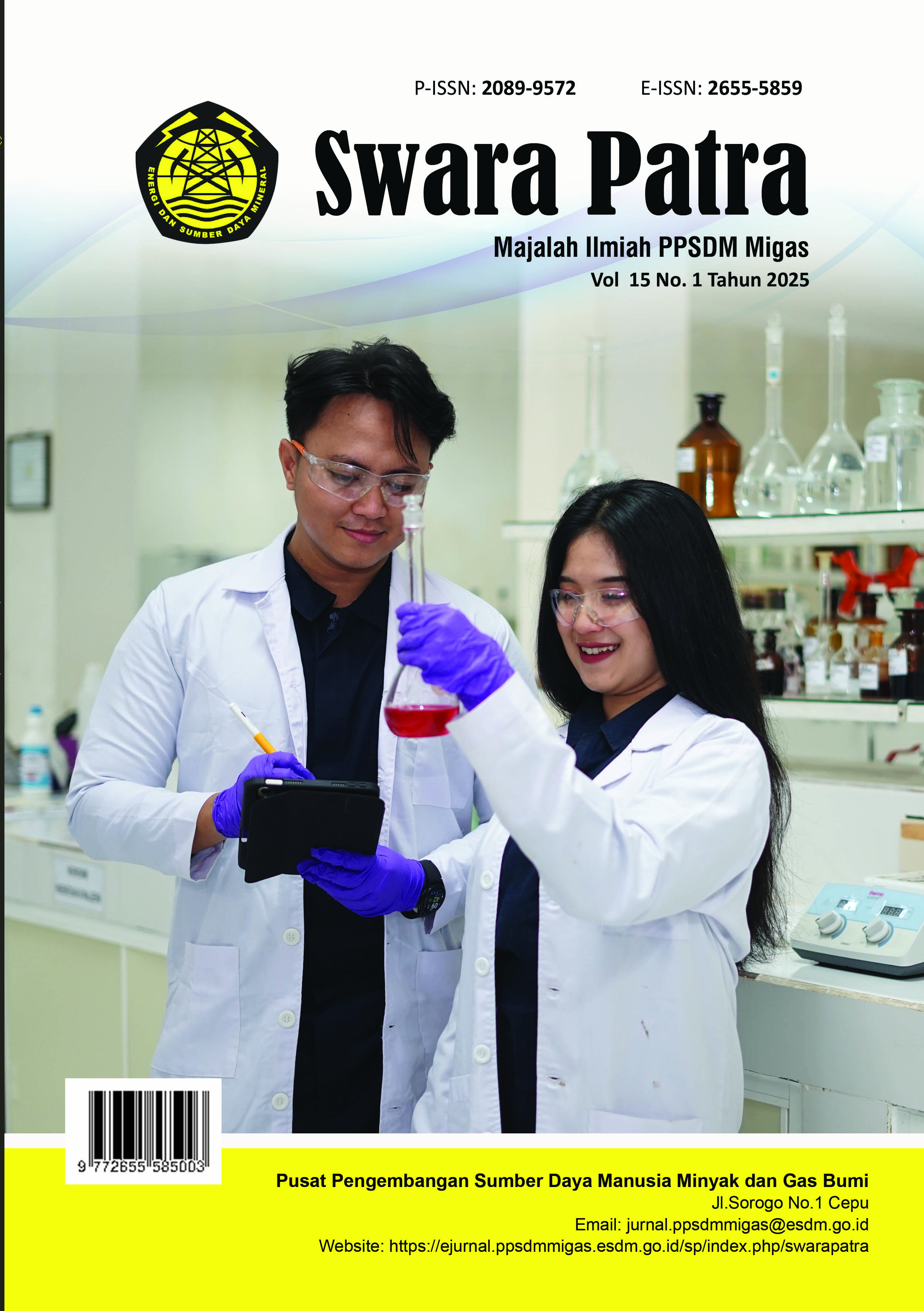Pemodelan 2D dan 3D Geolistrik dalam Identifikasi Struktur Geologi dan Potensi Mineral di Desa Wonosemi: Mendukung Pemanfaatan Sumber Daya Alam yang Berkelanjutan
DOI:
https://doi.org/10.37525/sp/2025-1/615Keywords:
Geolistrik, Pemodelan 2D dan 3D, Desa Wonosemi, Struktur Geologi, SDA BerkelanjutanAbstract
Penelitian ini bertujuan untuk mengeksplorasi potensi sumber daya mineral di Desa Wonosemi, Blora, Jawa Tengah, menggunakan metode geolistrik tahanan jenis dan polarisasi terinduksi (IP) dengan konfigurasi Schlumberger. Data diolah menggunakan perangkat lunak RES2DINV dan divisualisasikan secara spasial melalui pemodelan 3D menggunakan RockWorks. Hasil analisis menunjukkan dua potensi utama: (1) Akuifer dangkal dengan resistivitas rendah (1.87 – 2.78 Ωm) dan chargeability rendah (0.0272 – 0.818 msec) di kedalaman 0 – 23.7 m, yang berpotensi sebagai sumber air bersih berkelanjutan bagi masyarakat lokal. (2) Zona mineralisasi logam di kedalaman 23.7 – 40.523 m, ditandai oleh resistivitas sedang hingga tinggi (3.15 – 6.34 Ωm) dan chargeability tinggi (0.00272 – 20.5 msec), mengindikasikan keberadaan mineral sulfida seperti pirit dan kalkopirit.
Penelitian ini menegaskan bahwa penerapan teknologi geofisika dalam eksplorasi mineral adalah langkah penting dalam mengoptimalkan pengelolaan sumber daya alam secara berkelanjutan. Integrasi metode geolistrik memungkinkan visualisasi yang lebih detail terhadap struktur geologi, memberikan dasar yang kuat untuk strategi pengembangan berkelanjutan. Rekomendasi penelitian ini menyarankan kelanjutan eksplorasi menggunakan teknik geofisika untuk mengidentifikasi sumber daya mineral, dengan memperhatikan keseimbangan antara aspek lingkungan dan ekonomi guna mendukung pertumbuhan ekonomi lokal dan kesejahteraan masyarakat.
References
Afifah, S. B. (2008). PENGOLAHAN DATA GEOLISTRIK DENGAN METODE SCHLUMBERGER. TEKNIK, 29, 120-128.
Bagaskoro, M. B. (2023). Geografi Regional Kabupaten Glora. Surakarta: Universitas Muhammadiyah Surakarta.
Blora, D. K. (2017). Potensi Bahan Galian. Hämtat från Blorakab: https://www.blorakab.go.id/index.php/public/potenda/detail/102/potensi-bahan-galian-di-kabupaten-blora
D. A. Widiarso, I. A. (2017). Penentuan Potensi Sumberdaya Batu Gamping Sebagai Bahan Baku Semen Daerah Gandu Dan Sekitarnya, Kecamatan Bogorejo, Kabupaten Blora, Jawa Tengah. TEKNIK, 92-98.
Dahlin, T. &. (1998). Resolution of 2D Wenner resistivity imaging as assessed by numerical modelling. Journal of Applied Geophysics, 38(4), 237-249.
Jusfarida, S. R. (2022). PEMETAAN GEOLOGI UNTUK MENENTUKAN ZONA AKUIFER AIR TANAH MENGGUNAKAN GEOLISTRIK KONFIGURASI WENNER DI DESA WONOSEMI, KECAMATAN BANJAREJO, KABUPATEN BLORA, JAWA TENGAH. Seminar Nasional Sains dan Teknologi Terapan X (s. 105). Surabaya: Institut Teknologi Adhi Tama Surabaya.
Konstruksi, P. P. (2019). Modul 6 Analisis dan Interpretasi Data Geolistrik untuk Airtanah. Bandung: Pusat Pendidikan dan Pelatihan Sumber Daya Air dan Konstruksi.
Lingga, R. G. (2022). INTERPRETASI MODEL 3D RESISTIVITAS UNTUK MENENTUKAN SEBARAN DAN KETEBALAN BATUBARA DI DESA BARU MUORO JAMBI. Jambi: Universitas Jambi.
Loke, M. H. (1996). Rapid least-squares inversion of apparent resistivity pseudosections by a quasi-Newton method. Geophysical Prospecting, 44(1), 131-152.
Loke, M. H. (2004). Tutorial: 2D and 3D Electrical Imaging Surveys. Geotomo Software.
M.H. Loke, T. D. (2013). Smoothness-constrained time-lapse inversion of data from 3D resistivity surveys. Near Surface Geophysics.
Nabighian, M. N. (1991). Time domain electromagnetic prospecting methods. Electromagnetic Methods in Applied Geophysics, 2(1), 427-520.
Reynolds, J. (2011). An Introduction to Applied and Environmental Geophysics (2nd Edition uppl.). Wiley-Blackwell.
Roy, A. &. (1971). Depth of investigation in direct current methods. Geophysics, 36(5), 943-959.
Selvy Tiurma Simamora, S. C. (2020). Identifikasi Batuan Andesit Menggunakan Metode Geolistrik 2D di Daerah Pengaron, Kalimantan Selatan. Jurnal Fisika Unand (JFU), 487-494.
Telford, W. G. (1990). Applied Geophysic. USA: Cambridge University Press.
Veny Ruth J M Pardosi, D. N. (2017). Geologi Dan Studi Analisa Batuan Asal (Provenance) Batu Pasir Formasi Ngrayong Daerah Todanan Dan Sekitarnya Kecamatan Todanan Kabupaten Blora Jawa Tengah. Bogor: Fakultas Teknik Universitas Pakuan.
Zohdy, A. A. (1974). Use of Schlumberger and equatorial soundings in groundwater exploration. Geophysics, 39(5), 1062-1073.
Downloads
Published
How to Cite
Issue
Section
License
Copyright (c) 2025 Elia Ayunita

This work is licensed under a Creative Commons Attribution-ShareAlike 4.0 International License.
An author who publishes in the Majalah Ilmiah Swara Patra agrees to the following terms:
- Author retains the copyright and grants the journal the right of first publication of the work simultaneously licensed under the Creative Commons Attribution-ShareAlike 4.0 License that allows others to share the work with an acknowledgment of the work's authorship and initial publication in this journal
- Author is able to enter into separate, additional contractual arrangements for the non-exclusive distribution of the journal's published version of the work (e.g., post it to an institutional repository or publish it in a book) with the acknowledgment of its initial publication in this journal.
- Author is permitted and encouraged to post his/her work online (e.g., in institutional repositories or on their website) prior to and during the submission process, as it can lead to productive exchanges, as well as earlier and greater citation of the published work (See The Effect of Open Access).
Read more about the Creative Commons Attribution-ShareAlike 4.0 Licence here: https://creativecommons.org/licenses/by-sa/4.0/.














